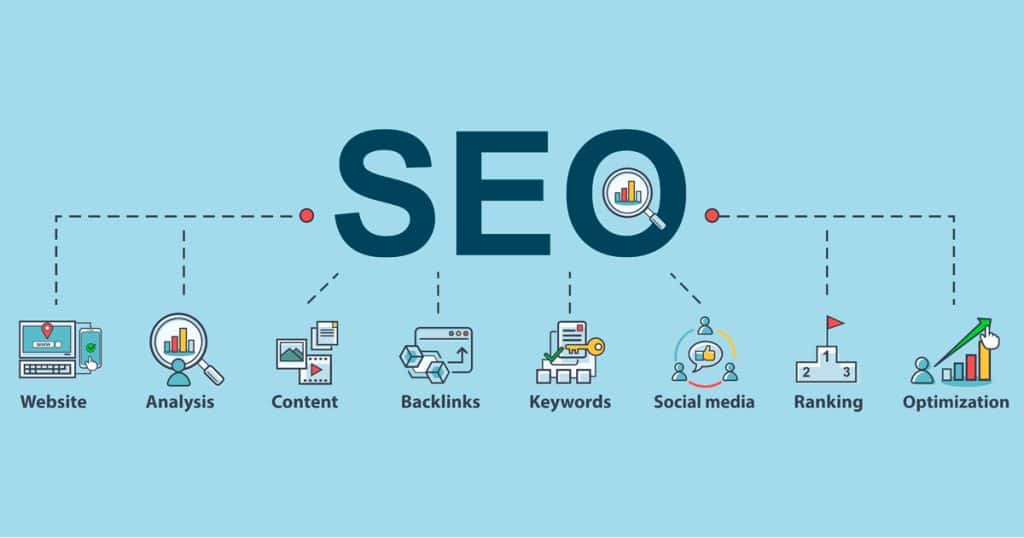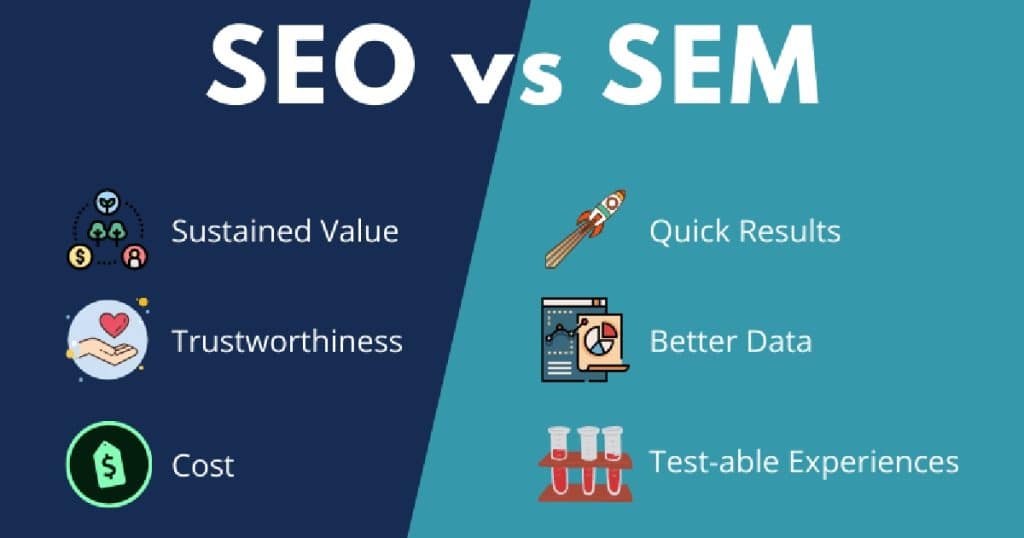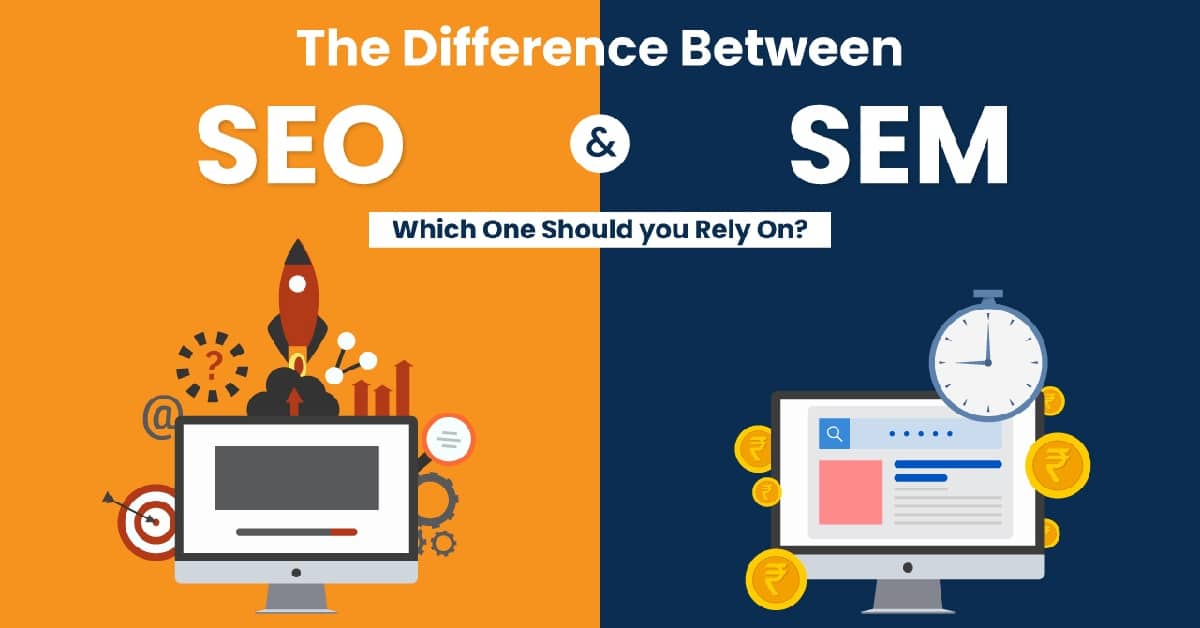Understanding the Basics of Search engine optimization and search engine marketing are two digital marketing strategies that are often used interchangeably, but they are actually quite different. While both strategies aim to increase website traffic and improve online visibility, they use different methods to achieve these goals. In this article, we will explore the key differences between them, and how they can be used together to create a more effective digital marketing strategy.
- What is SEO?

Search engine optimization (SEO) is the process of optimizing a website to improve its visibility and ranking on search engines like Google, Bing, and Yahoo. The goal of SEO is to increase the quantity and quality of organic (non-paid) traffic to a website. SEO experts use a variety of techniques to make a website more attractive to search engines. This includes things like keyword research, meta tags, and backlinks. By optimizing a website for search engines, businesses can increase their visibility and reach a larger audience.
One of the most important techniques used in SEO is keyword research. This involves identifying the terms and phrases that people are searching for in relation to your products or services. By including these keywords in your website’s content and meta tags, you can make your site more relevant to search engines. This will help your website show up in the search results when people are searching for those keywords.
Another important technique is meta tags. Meta tags are HTML tags that provide information about a web page to search engines. These tags include the title tag, which appears in the search engine results, and the meta description, which provides a brief summary of the page’s content. By including relevant keywords in these tags, you can make your website more attractive to search engines.
Backlinks are also an important aspect. Backlinks are links from other websites that point to your website. When other websites link to your site, it sends a signal to search engines that your content is valuable and relevant. This can help improve your website’s ranking on search engine results pages.
- What is SEM?
Search engine marketing (SEM) is the process of using paid advertising to promote a website or product on search engines. SEM campaigns use pay-per-click (PPC) advertising, which means that businesses only pay when someone clicks on their ad. This can include ads that appear at the top of search engine results pages, as well as ads that appear on other websites. The goal of SEM is to increase website traffic by purchasing visibility on search engines.
One popular method of SEM is Google AdWords. AdWords is a pay-per-click advertising platform that allows businesses to create ads that appear at the top of search engine results pages. These ads are targeted to specific keywords and demographics, allowing businesses to reach their desired audience. Additionally, AdWords provides detailed analytics and reporting, allowing businesses to measure the success of their campaigns.
Another popular SEM method is Bing Ads. Bing Ads is a pay-per-click advertising platform that allows businesses to create ads that appear on Bing search engine results pages, as well as other websites in the Bing network. Like AdWords, Bing Ads allows businesses to target specific keywords and demographics, and provides analytics and reporting to measure the success of their campaigns.
Social media advertising is also considered as a SEM, platforms like Facebook, Instagram, LinkedIn, and Twitter allow businesses to create ads and target specific demographics, interests, behaviors and more. These platforms provide a lot of targeting options and targeting capabilities that allow businesses to reach their desired audience.
SEM is a powerful tool for increasing website traffic, but it requires ongoing investment to maintain visibility. By using SEM platforms such as AdWords and Bing Ads, businesses can purchase visibility on search engines and see immediate results. Additionally, businesses can use social media advertising to reach their desired audience and increase their website traffic.
- Key Differences between SEO and SEM:

There are a few key differences between SEO and SEM. SEM is a broader term that includes SEO, but also paid search engine marketing activities like paid inclusion, paid listings, and paid search advertising.
1. SEO is a long-term strategy, while SEM is more immediate.
It is all about optimizing your website and content so that you can rank higher in search engine results pages (SERPs). This takes time and effort, but the payoff can be big if you’re successful. SEM, on the other hand, is all about buying ads on search engines. This can be a more immediate way to get your business in front of potential customers, but it can also be more expensive.
2. SEO focuses on organic search results, while SEM includes both organic and paid results.
When you do a search on Google, you’ll see two types of results: organic and paid. Organic results are those that are generated algorithmically, and they’re the results that you get naturally based on your search query. Paid results are the ones that you see at the top of the page, and they’re the results that businesses have paid to have appeared there.
3. SEO is free, while SEM can be expensive.
One of the main advantages of SEO is that it’s free. You don’t have to pay to rank higher in search engine results pages, although you may need to invest in some SEO tools and services. SEM, on the other hand, can be expensive. You’ll need to pay for ads to appear in the SERPs, and you may also need to invest in other marketing activities like search engine optimization, social media marketing, or email marketing.
4. SEO is a long-term investment, while SEM can be a short-term investment.
SEO is a long-term investment because it takes time to see results. You may not see any change in your website’s rank for months or even years, but if you’re successful, you’ll see a big payoff in the long run. SEM, on the other hand, can be a short-term investment. You may see results fairly quickly, but you’ll also need to continue investing in SEM in order to maintain those results.
5. SEO is more organic, while SEM is more targeted.
SEO is more organic because it’s based on optimizing your website and content to rank higher in the SERPs. SEM is more targeted because you’re paying to have your ads appear in specific places. You can target your ads to specific demographics, locations, and interests, which can help you reach more potential customers.
6. SEO focuses on building a strong foundation for your website, while SEM focuses on driving traffic to your website.
SEO is about making sure that your website is technically sound, user-friendly, and optimized for search engines. This includes things like keyword research, on-page optimization, and backlink building. SEM, on the other hand, is about driving traffic to your website by purchasing ads and paying for visibility in the SERPs. This can be a quick way to get more visitors to your website, but it doesn’t build the same long-term foundation as SEO.
7- SEO is a more passive approach, while SEM is a more active approach.
SEO is a more passive approach because once you’ve optimized your website, you’re mainly waiting for search engines to find and index your content. SEM is a more active approach because you’re actively purchasing ads and bidding on keywords to drive traffic to your website.
8. SEO and SEM work best when used together.
While SEO and SEM are two different strategies, they can complement each other and work together to help you achieve your online marketing goals. By optimizing your website for search engines, you can build a strong foundation for your online presence. And by purchasing ads and driving traffic to your website, you can increase visibility and reach more potential customers.
In conclusion, SEO and SEM are both essential strategies for increasing a website’s visibility in search engine results, but they are distinct and serve different purposes. SEO focuses on improving a website’s organic search rankings through techniques like keyword research, on-page optimization, and link building. SEM, on the other hand, involves paid advertising, such as through Google AdWords, to boost a website’s visibility in search results. Both SEO and SEM can be used together to maximize a website’s potential for visibility and traffic.
However, it’s important to understand the differences between the two and avoid common SEO mistakes such as keyword stuffing, duplicate content, and ignoring mobile optimization. Additionally, avoid buying backlinks, using hidden text or links, and using irrelevant keywords. By understanding the distinctions between SEO and SEM, and avoiding these common mistakes, you can choose the best approach for your business and achieve the best results.
Related article
 Anas is our go-to copywriter with a knack for crafting persuasive and high-converting eCommerce landing pages. His passion for words and understanding of consumer psychology helps turn visitors into loyal customers. When he's not refining his copy, Anas enjoys exploring the latest digital marketing trends and experimenting with new writing techniques. His blend of creativity and strategic thinking makes him an indispensable part of our energetic team.
Anas is our go-to copywriter with a knack for crafting persuasive and high-converting eCommerce landing pages. His passion for words and understanding of consumer psychology helps turn visitors into loyal customers. When he's not refining his copy, Anas enjoys exploring the latest digital marketing trends and experimenting with new writing techniques. His blend of creativity and strategic thinking makes him an indispensable part of our energetic team.












